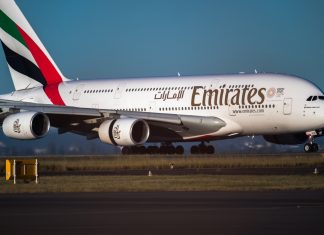Over the past ten years, the world has seen economic ebbs and flows, evolving global competition and partnership, and boundless technological innovation. But, one thing has remained constant: people’s growing desire to travel the world, visit new landscapes and immerse themselves in other cultures.
Mastercard’s Global Destination Cities Index, released, quantifies this desire: since 2009, the number of international overnight visitors grew an astounding 76 percent.
This year, the Global Destination Cities Index—which ranks 200 cities based on a proprietary analysis of publicly available visitor volume and spend data—reveals that Bangkok remains the No. 1 destination, with more than 22 million international overnight visitors. Paris and London, in flipped positions this year, hold the No. 2 and 3 spots, respectively both hovering over 19 million. All top ten cities saw more international overnight visitors in 2018 than the prior year, with the exception of London, which decreased nearly 4 percent. The forecast for 2019 indicates across-the-board growth, with Tokyo expecting the largest uptick in visitors.
When looking at the cities by dollar spent, Dubai tops the list with travelers spending USD $553 on average a day. Makkah, new to the top 10 last year, remains at No. 2 for the second consecutive year, with Bangkok rounding out the top three.
Notably this year, the Global Destination Cities Index offers a decade of insights to consider, with three key trends standing out.
- Consistent & Steady Growth: Over the past decade, the one constant has been continual change. Each year, more people are traveling internationally and spending more in the cities. Between all of the destinations within the Index, arrivals have grown on average 6.5 percent year-over-year since 2009, with expenditure growing on average 7.4 percent.
- The Sustained Dominance of Major Cities: While there has been significant movement in visitors to smaller cities, the top 10 has remained largely consistent. London, Paris and Bangkok have been the top 3 since 2010, with Bangkok as No. 1 six of the past seven years. New York is another top 10 stalwart, with 13.6 million overnight visitors this year.
- The Rise of Asia-Pacific International Travelers: Cities in the Asia-Pacific region have seen the largest increase in international travelers since 2009, growing 9.4 percent. In comparison, Europe, which saw the second-highest growth, was up 5.5 percent. This is spurred on by the growth in mainland Chinese travelers. Since 2009, mainland China has jumped up six places to be the No. 2 origin country for travelers to the 200 included destinations—behind only the U.S.
| The Global Top 10 Destination Cities in 2018 | ||||
| 2018 International Overnight Visitors | Growth Forecast for 2019 | Average Length of Stay | Average Spend Per Day (USD) | |
| Bangkok | 22.78 million | 3.34% | 4.8 nights | $184 |
| Paris | 19.10 million | 2.24% | 2.5 nights | $296 |
| London | 19.09 million | 3.47% | 5.8 nights | $148 |
| Dubai | 15.93 million | 1.68% | 3.5 nights | $553 |
| Singapore | 14.67 million | 4.0% | 4.2 nights | $272 |
| Kuala Lumpur, Malaysia | 13.79 million | 9.87% | 5.7 nights | $142 |
| New York | 13.60 million | 2.94% | 7.9 nights | $152 |
| Istanbul | 13.40 million | 8.14% | 5.8 nights | $106 |
| Tokyo | 12.93 million | 10.02% | 5.4 nights | $196 |
| Antalya, Turkey | 12.41 million | 8.14% | 14.0 nights | $44 |
| Top Cities by Dollars Spent in 2018 | |||
| 2018 International Overnight Visitor Spend (USD) | Forecast for 2019 | Average Spend by Day (USD) | |
| Dubai | $30.82 billion | 4.18% | $553 |
| Makkah, Saudi Arabia | $20.09 billion | 7.94% | $135 |
| Bangkok | $20.03 billion | 8.67% | $184 |
| Singapore | $16.56 billion | 2.66% | $272 |
| London | $16.47 billion | 4.64% | $148 |
| New York | $16.43 billion | 2.93% | $152 |
| Paris | $14.06 billion | -0.78% | $296 |
| Tokyo | $13.77 billion | 12.74% | $196 |
| Palma de Mallorca, Spain | $12.69 billion | 3.17% | $233 |
| Phuket, Thailand | $12.01 billion | 9.16% | $247 |
“In today’s interconnected world, travel has become an important part of how we work and how we live,” said Carlos Menendez, president, Enterprise Partnerships. “It’s critical for us to understand how travel impacts cities and destinations for the better and the challenges it poses, to ensure local leaders have the information and solutions they need to succeed.”
Addressing the challenges and opportunities of global tourism is too big a task for one organization, industry or government alone. Bringing together resources from across disciplines and sectors – public and private – helps tourism partners better understand commerce patterns and deliver more connected and inclusive experiences.
As a key technology partner for the global travel and tourism industry, Mastercard provides solutions, insights and consulting services that address destinations’ unique needs. In addition, Mastercard pioneered City Possible, the global partnerships and co-creation initiative for cities, research institutions and private sector organizations. The initiative identifies and addresses urban challenges through scalable solutions in areas such as digital inclusion and economic development.


























